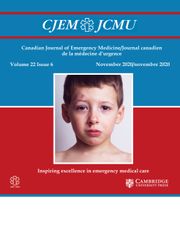No CrossRef data available.
Article contents
P121: A quality improvement project to improve medical imaging ordering workflow in the emergency department
Published online by Cambridge University Press: 13 May 2020
Abstract
Background: Many computerized tomography (CT) scans ordered after-hours from the emergency department (ED) at our institution required a discussion between the emergency physician (EP) and radiology resident (RR), leading to workflow inefficiency. Aim Statement: The aim was to improve workflow efficiency and provider satisfaction, and reduce CT turnaround time, without significantly affecting CT utilization within six months. Measures & Design: We created a new workflow by creating an electronic list of ED CT requests that RRs monitor. RRs protocolled all requests and only called the ED physician for more details when required. The intervention was implemented in a stepwise fashion via plan-do-study-act cycles. An electronic survey measured qualitative outcomes, and quantitative outcomes were analyzed via statistical process control (SPC) charts and other statistical methods. Evaluation/Results: Survey response was high (76% EP, 79% RR). Most EPs and RRs felt more efficient (96.3%, 73.3%), RRs felt fewer disruptions (83.3%), and most EPs felt that scans were done faster (84.1%). We analyzed CT turnaround times and utilization using SPC charts and segmented regression analyses. Turnaround time trended to improvement (33 mins vs 29 mins on weekdays [WD], 37 mins vs 33 on weekends [WE]), but was not statistically significant. There was background rising CT utilization over time (+0.7 and + 1.9 CT/100 ED visits/year on WD and WE, respectively, p < 0.0005), but the intervention itself did not cause a significant change. The total number of pages to RR (a measure of workflow disruption) decreased significantly on the WDs (23 vs 19 pages, p = 0.0011), but not on WE (79 vs 75 pages, p = 0.1663). However when adjusting for number of scans ordered, there was a decrease in paging rates (0.73 vs 0.54 pages per scan ordered on WD [p < 0.00005], 3.24 vs 2.63 pages per scan ordered on WE [p = 0.0012]). Discussion/Impact: Our intervention led to improved work satisfaction and perceived efficiency experienced by both EPs and RRs. It did not statistically significantly affect imaging turnaround times or utilization rates. Our project shows that calling for preapproval of imaging studies does not seem to provide any benefit in our setting.
Keywords
- Type
- Poster Presentations
- Information
- Copyright
- Copyright © Canadian Association of Emergency Physicians 2020


